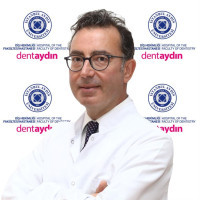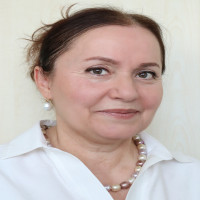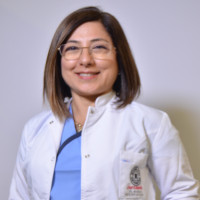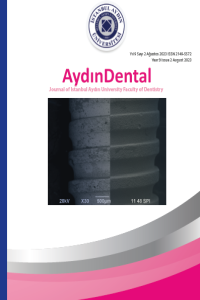Research Article
Review
Case Report
Issue Editorial Board





Aim & Scope
The aim of DENTAL is to create a source for academics and scientists who are doing research in the media, technology and communication that feature formally well-written quality works. And also create a source that will contribute and help develop the fields of study. Accordingly, DENTAL’s intentions are on publishing articles and scientific works which are guided by a scientific quality sensibility. In this context, DENTAL is qualified as an “international peer-reviewed journal”.
- Aydın Dental Journal is a peer-reviewed scientific publication of Istanbul Aydın University Faculty of Dentistry, published 3 times a year, in April-August and December.
Author Guidelines
Title Page: A separate title page should be uploaded to the system with all articles. Title page should include:
- The full title of the article and its short title not exceeding 50 characters, (It is recommended not to use abbreviations in the titles)
- Author Information: ORCID IDs, affiliated institution and e-mail address information of all authors should be specified.
- The phone number and address information of the corresponding author should also be specified.
-Conflict of interest: 'None of the authors of this article has any relationship, connection or financial interest in the subject matter or material discussed in the article'. Otherwise, the interest/relationship should be declared. Example: 'Author A holds shares in company X, author B has received consultancy fees from company Y, a competitor of the manufacturer of the material mentioned in the article, in the last 2 years', etc.
Summary/Abstract Section
- The Abstract/Abstract section should be uploaded to the system as an additional file separate from the main text section.
- The article should contain Turkish abstract and English abstract sections. In addition, the article should have both Turkish and English titles.
- The number of words for English and Turkish abstracts should be 250 words at most.
- Keywords should be in alphabetical order and their number should be between 3-5. Keyword selection should be based on Medical Subject Headings (MESH; www.nlm.nih.gov/mesh/MBrowser.html ) and Turkish Science Terms (TBT; http://www.bilimterimleri.com).
- Detailed information on financial support information and other support resources should be provided.
Special thanks to the individuals who contributed to the article preparation process but did not meet the authorship criteria should be given under the acknowledgment heading.
Language of the Article: English and Turkish.
Font: Times New Roman, 12 pt, Line spacing 1.15 cm and justified.
Page structure: There should be 2.5 cm margins from all sides in the text writing area.
Line Numbering: Except for the Summary/Abstract section, the line number of all lines of the text should be specified.
Abbreviations: In the first place of the word in the text, the abbreviation should be given in parentheses and the abbreviation should be used in the rest of the text.
Figures and Paintings: All figures and paintings must be uploaded as a separate file. In original research, the number of tables and figures should not exceed 8 in total.
Representation of references in the text: It should be placed after the punctuation mark at the end of the sentence as Superscript.
Bibliography Format: Must be in Vancouver style.
For the Article: Author surname, initials, title of the article, abbreviation of the journal name, year, volume, issue, page, DOI.
Example: Moher D, Liberati A, Tetzlaff J, Altman DG. Preferred reporting items for systematic reviews and meta-analysis: the PRISMA statement. Ann Intern Med 2009;151(4):264-9, W64.
For the Book: Editor, book title, edition number, publisher, year.
Example: Arens AA. Auditing in Australia : an integrated approach. 5th ed. Frenchs Forest: Pearson Education Australia; 2002.
Book Chapter: Author names, book title, edition number, publishing house, publication year, chapter number and title, Page number.
Example: Thomas, G. Medicinal Chemistry. 2nd ed. Chichester: John Wiley; 2007. Chapter 8.2, The chemical nature of the binding of ligands to receptors; p.252-254.
Thesis: Author's name, Thesis title, City, Institution, Year.
Example: Evans PR. Motor and sensory function of the upper digestive tract in health and in irritable bowel syndrome [Ph.D Thesis]. Sydney, NSW: University of Sydney; 1998.
Original studies presented at scientific meetings are evaluated, provided that they are stated.
TYPES OF ARTICLES
1) Original Research Article: Clinical and experimental studies are evaluated in this category.
Summary Section; It should include the headings of “Purpose”, “Materials and Methods”, “Results”, “Conclusion” and “Keywords”.
Abstract Section; It should include “Objectives”, “Materials and Methods”, “Results”, “Conclusion” and “Keywords” headings.
Turkish article; It should include “Introduction”, “Material and Methods”, “Results”, “Discussion”, “Conclusion” and “Keywords” headings.
English article; It should include “Introduction”, “Materials and Methods”, “Results”, “Discussion” “Conclusion” and “Keywords” headings.
2) Review: It is accepted on the condition that it is prepared comprehensively and systematically to include the current literature for all controversial issues in the field of dentistry. For reviews, it is preferred that the author or authors are experienced in the subject and have full-text studies published on the subject.
The compilation text should contain the titles that the author will specify in accordance with the subject and the "Conclusion/Conclusion" sections.
3) Case Reports: A limited number of places are reserved for case reports, and only cases with interesting and instructive features, which are related to rare diseases that are difficult to diagnose and treat, suggest a new method, reflect information that are not included in the books, are accepted for publication.
Texts prepared in Turkish; It should include the sub-titles "Introduction", "Case Report" and "Conclusion".
Texts prepared in English; “Introduction”, “Case Report”, “Conclusion”, “References” headings should be used.
4) Letter to the Editor: Can discuss the importance, overlooked detail or missing parts of an article previously published in the journal. In addition, articles can be published in the form of a letter to the editor on topics that may interest the readers in the fields covered by the journal, and especially on educational facts. Readers can also submit their articles in Letter to the Editor format, which includes comments on published articles. Abstract, keywords, tables, figures, pictures and other images are not used. The main text should be without subtitles. The volume, year, issue, page numbers, title of the article and the names of the authors of the publication about which the letter is written should be clearly stated, written in the reference list and cited in the text.
ADDITIONAL INFORMATION TO BE CONSIDERED
Article Text: It should be uploaded to the system as a single Word file, without adding pictures and tables.
Pictures and Picture Captions: Pictures, graphics and photographs (in TIFF or JPEG format) must be uploaded to the system as separate files. Images must have a minimum resolution of 300DPI. All submitted images must have a clear resolution and a large size (minimum dimensions 100x100 mm) to avoid disruptions in the evaluation process. Explanations should be added under figures, pictures, tables and graphics.
Table: Tables must be loaded in editable table format. It is recommended not to use vertical lines in the table.
Similarity Report: Similarity report should be uploaded as a separate file. The similarity should be at most 15%.
Ethics Committee Document: Ethics committee approval documents must be uploaded in original research articles. For studies that do not require ethics committee approval, it should be stated why an ethics committee is not required.
Patient Consent Form: The patient's voluntary consent form must be uploaded for case reports.
Conflict of Interest Form: Aydın Dental Journal; requests and encourages authors and individuals involved in the evaluation process of submitted articles to declare any existing or potential conflicts of interest, including financial, institutional and other relationships that may lead to potential conflicts of interest or bias. Any financial support or other support received from an individual or institution for a study should be declared to the Editorial Board and the Conflict of Interest Form on the journal website should be signed by all authors in order to declare potential conflicts of interest. Cases of potential conflicts of interest with editors, authors, and reviewers are resolved by the journal's Editorial Board under the COPE and ICMJE guidelines.
Ethics Committee Permission: For research articles, the ethics committee permission file should be uploaded and the ethics number and institution should be included in the Materials and Methods section.
Informed Consent Form: In case reports, the patient's/signed informed consent form should be uploaded and the statement that the patient's consent was obtained should be included in the Materials and Methods section.
Ethical Principles and Publication Policy
Principles of Research and Publication Ethics
In scientific papers sent to IAUD, the guidelines related to the Scientific Research and Publication Ethics of Higher Education Institutions, the recommendations of the International Committee of Medical Journal Editors and the International Standards for the Authors and Authors of the Committee should be taken into attention. Plagiarism, forgery in the data, misleading, repetition of publications, divisional publication and individuals who do not contribute to the research are among the authors are unacceptable practices within the ethical rules. Legal actions will be taken in case of any ethical irregularity related to this and similar practices.
a)Plagiarism: Placing the original ideas, methods, data, or works of others, partly or completely, without making reference to the scientific rules, is dealt with in the context of plagiarism. In order to avoid plagiarism, the authors should refer to the scientific rules in a manner that is appropriate and should pay attention to the references of all scientific papers in their research.
b)Forgery of Data: The use of data that does not exist or is modified in scientific research is data in the scope of forgery. Authors should analyze their data in accordance with ethical rules and without exposing them to a change in validity and reliability during the process.
c)Detortion: Changing the records or data obtained from the study, showing the devices or materials that are not used in the research as used, changing or shaping the research results according to the interests of the people and organizations that are supported are considered within the scope of distortion. The authors should be honest, objective and transparent in the information they provide in relation to the research process. They should avoid violating the rules of ethics.
d)Repetition: Presenting the same publication as separate publications without referring to the previous publications is considered within the scope of repetition of publications. The responsibility for the publication of the publications submitted for evaluation in another place or in the evaluation process belongs to the authors. The authors should refrain from repeating the original and original research and they should pay attention to submit their original and original research.
e)Divisional Publication: The results of a research are discussed in the scope of dissemination and disseminating the results of the research in a way that disrupts the integrity of the research and disseminating it in more than one way, and publishing these publications as separate publications. The authors should consider the integrity of the research and avoid the divisions that will affect the results.
f)Authorship: The inclusion of people who do not contribute to the research or not to include the people who have contributed is considered within the scope of unfair writing. All authors should have contributed sufficiently to the planning, design, data collection, analysis, evaluation, preparation of the research and finalization of the research.
Ethics Committee Approval
"Ethics Committee Permission" is required for the following researches. The institution from which the "Ethics Committee Permission" was obtained, its date and number should be stated in the "Materials and Methods" section of the study. You must upload the "Ethics Committee Permission" document to the system. Studies that require the approval of the Ethics Committee are as follows:
Any kind of researches carried out with qualitative or quantitative approaches that require data collection from participants using questionnaire, interview, focus group works, observation, experiment, interview techniques,
· Usage of humans and animals (including material / data) for experimental or other scientific purposes,
· Clinical researches on humans,
· Researches on animals,
· Retrospective studies in accordance with the Law on Protection of Personal Data,
Also;
· Stating that “Informed consent form” has been taken in the case reports,
· Obtaining and specifying the permission of the owners for the use of scales, questionnaire and photos belonging to others,
· Stating that copyright regulations are obeyed for the ideas and works of art used.
In these articles, “Ethics Committee Approval ” should be stated in the article. The articles should include the statement that Research and Publication Ethics are complied with.
Price Policy
Dergi için herhangi bir ücret talep edilmemektedir. Ayrıca kabul edilen bütün makaleler ücretsiz yayımlanmaktadır.
All site content, except where otherwise noted, is licensed under a Creative Common Attribution Licence. (CC-BY-NC 4.0)






